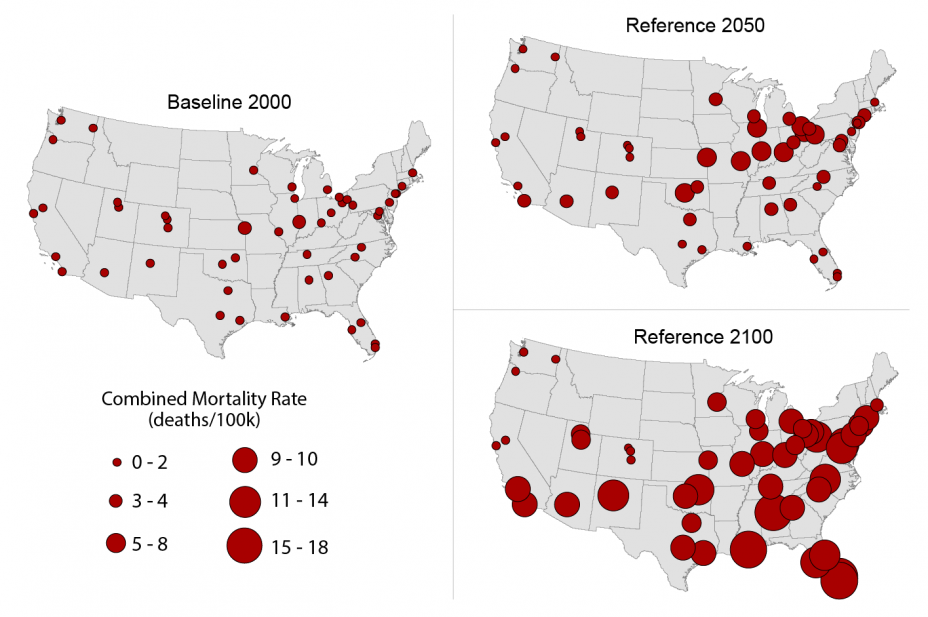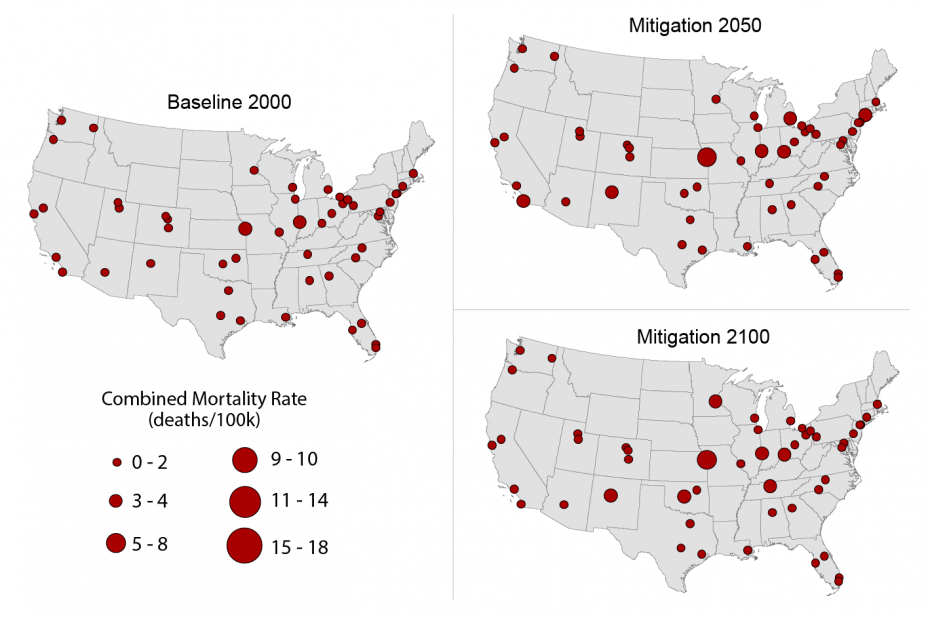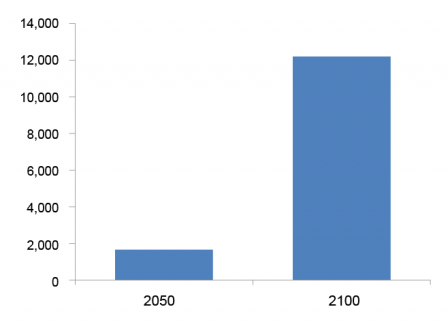Climate Action Benefits: Extreme Temperature

Climate change will alter the weather conditions that we are accustomed to. Extreme temperatures are projected to rise in many areas across the U.S., bringing more frequent and intense heat waves and increasing the number of heat-related illnesses and deaths.21 Exposure to extreme heat can overwhelm the body’s ability to regulate its internal temperatures, resulting in heat exhaustion and/or heat stroke, and can also exacerbate existing medical problems, such as heart and lung diseases.22 During a 1995 heat wave in Chicago, an estimated 700 individuals died as a result of the extreme heat.23 Warmer temperatures are also expected to result in fewer extremely cold days, which may also reduce deaths associated with extreme cold.24
On this page:
Additional information:
Key Findings
- Without global GHG mitigation, the average number of extremely hot days in the U.S. is projected to more than triple from 2050 to 2100. The projected reduction in deaths from extremely cold days is more than offset by the projected increase in deaths from extremely hot days. This result holds for all reported future years, indicating that unmitigated climate change clearly poses an increasing health risk from extreme temperatures.
- Global GHG mitigation is projected to result in approximately 12,000 fewer deaths from extreme temperature in the 49 modeled cities in 2100. Inclusion of the entire U.S. population would greatly increase the number of avoided deaths, but accounting for adaptation would decrease the number.
Risks of Inaction
Climate change poses a significant risk to human health as more days with extreme heat are projected to cause more deaths over time. Without global GHG mitigation, the average number of extremely hot days is projected to more than triple from 2050 to 2100, while the number of extremely cold days is projected to decrease. The projected increase in deaths due to more frequent extremely hot days is much larger than the projected decrease in deaths due to fewer extremely cold days, a finding that is consistent with the conclusions of the assessment literature.25 Under the Reference, the net increase in projected deaths from more extremely hot days and fewer extremely cold days in 49 cities is approximately 2,600 deaths in 2050, and 13,000 deaths in 2100. Figure 1 shows the net mortality rate from extreme hot and cold temperatures by city in the Reference scenario.
Figure 1. Projected Extreme Temperature Mortality in Select Cities Due to Unmitigated Climate Change
 Estimated net mortality rate from extremely hot and cold days (number of deaths per 100,000 residents) under the Reference scenario for 49 cities in 2050 and 2100. Red circles indicate cities included in the analysis; cities without circles should not be interpreted as having no extreme temperature impact.
Estimated net mortality rate from extremely hot and cold days (number of deaths per 100,000 residents) under the Reference scenario for 49 cities in 2050 and 2100. Red circles indicate cities included in the analysis; cities without circles should not be interpreted as having no extreme temperature impact.
download the figure; download the data
Figure 2. Projected Extreme Temperature Mortality in Select Cities with Global GHG Mitigation
 Estimated net mortality rate from extremely hot and cold days (number of deaths per 100,000 residents) under the Mitigation scenario for 49 cities in 2050 and 2100. Red circles indicate cities included in the analysis; cities without circles should not be interpreted as having no extreme temperature impact.
Estimated net mortality rate from extremely hot and cold days (number of deaths per 100,000 residents) under the Mitigation scenario for 49 cities in 2050 and 2100. Red circles indicate cities included in the analysis; cities without circles should not be interpreted as having no extreme temperature impact.
download the figure; download the data
Figure 3. Avoided Extreme Temperature Mortality in 49 U.S. Cities Due to Global GHG Mitigation
 download the figure; download the data
download the figure; download the data
Reducing Impacts through GHG Mitigation
As shown in Figure 2, the projected mortality rates under the Mitigation scenario show small changes through 2100, unlike in the Reference where rates increase substantially. As a result, the net benefits associated with GHG mitigation increase over time. As shown in Figure 3, global GHG mitigation is estimated to result in significant public health benefits by substantially reducing the risk of extreme temperature-related deaths across the U.S. Under the Mitigation scenario, extreme temperature mortality is reduced by 64% in 2050 and by 93% in 210026 compared to the Reference. For the 49 cities analyzed, global GHG mitigation is projected to save approximately 1,700 U.S. lives in 2050, and approximately 12,000 U.S. lives in 2100 (Figure 3).
In 2050, the economic benefits of GHG mitigation are estimated at $21 billion, increasing to $200 billion in 2100 (see the Approach section for more information). It is important to note that these projections reflect only the results for the 49 cities included in this study; corresponding national benefits would be much larger.
The analysis also examines the implications of adjusting temperature thresholds to account for potential adaptation of the human body to warmer temperatures. Specifically, the analysis assumes that the human health response to extreme temperatures in all 49 cities was equal to that of Dallas. Using this approach, results show that mitigation would still save a projected 5,500 lives in 2100 compared to the Reference.
Approach
The CIRA analysis estimates the number of deaths over the course of the 21st century attributable to extreme temperatures in 49 cities in the contiguous U.S., which account for approximately one third of the national population. City-specific relationships between daily deaths (of all causes) and extreme temperatures are combined with the IGSM-CAM projections of extremely hot and cold days using city-specific extreme temperature thresholds to estimate future deaths from heat and cold in the Reference and Mitigation scenarios. Extremely hot days are defined as those with a daily minimum temperature warmer than 99 percent of the days in the period 1989-2000. Extremely cold days are defined as those with a daily maximum temperature colder than 99 percent of the days in the period 1989-2000. As a result, the study explicitly addresses the question of the net mortality impact of climate change on future extreme temperature days. The potential impact of future population change is accounted for using an EPA demographic model (ICLUS).27 To monetize the effects of changing mortality, a baseline value of statistical life (VSL) of $9.45 million for 2010 (2014$) is used, adjusted to future years by assuming an elasticity of VSL to GDP per capita of 0.4.28 The results presented in this section have been updated since Mills et al. (2014) to include additional cities and more recent mortality rate data.29 Finally, this analysis did not estimate impacts across ages or socioeconomic status. As these demographics change, they could impact the results presented here.
For more information on the CIRA approach and results for the extreme temperature mortality sector, please refer to Mills et al. (2014).30
